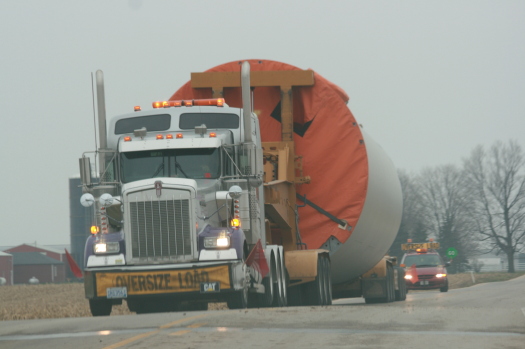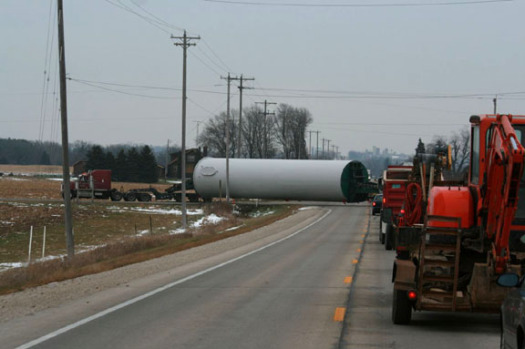12/16/08 C is for Construction: PART FOUR of our look at the history and contents of the Town of Union's Large Wind Ordinance: Impacts to Town Roads AND Turbine Road Related Problems in the News
C is for CONSTRUCTION:
Road Rules
These photos were taken in Fond du Lac, County, Wisconsin, 2008 during the construction phase of the 86 turbine industrial wind plant near the town of Byron. The large equipment required for industrial scale turbine construction can cause serious damage to rural roads.
Then what?


The Town of Union’s large wind ordinance does more than just set noise limits or setback distances between homes and industrial scale turbines. It also addresses the issue of responsibility for damage done to Town roads during the construction phase of the project.
Why is the construction phase so hard on rural roads?
Most rural roads aren’t ready for the size, weight, number of loads and vibration caused by heavy machinery and equipment required for such a project, and most communities aren’t prepared for the disruption and damage they leave behind.
What kind of equipment and machinery are we talking about?
For the construction of the 88 turbine Blue Sky, Green Field Industrial wind plant in Fond du Lac County, the construction period was estimated to last up to ten months. And during that ten months, was estimated that residents would have to share the road with over 9,000 trucks and other heavy equipment.
They included
Excavators
Bulldozers
Graders
Water Trucks
Concrete pumps
Cranes
Forklifts
Trailers
Plows
Trenchers
5,000 Gravel Trucks,
2,750 Cement trucks
Nearly 200 low boy and flat bed semis
For a total of over 8,200 trucks for construction materials.
Add onto that 880 oversized truck loads for the turbine parts--
You get 9,000 heavy trucks coming in and 9,000 trucks rolling out.
The trucks carrying the turbine parts are larger and weigh more than standard size.
Now add the weight of the turbine components:
The tower weight over 140 tons
Hub assembly over 15 tons
Blades over 6 tons each
Nacelle containing gearbox and generator over 53 tons.
To accommodate such loads, roads need to be widened, culverts filled in, traffic signs removed, electrical lines taken down, and new driveways have to be created, as each turbine needs its own permanent access road.
Who is responsible for restoring the roads to pre-construction condition?
It seems like a simple question, but the answer is anything but simple.
Small towns across the country have reported being left with considerable road damage from large scale wind turbine construction or poorly done repairs using substandard materials.
The question of who is responsible can get tossed between wind developer, contractor, town, county, and state for months without resolution. In the meantime, residents are stuck with damaged roads.
The Town of Union’s large wind ordinance directly addresses this problem.
(CLICK HERE TO DOWNLOAD THE ENTIRE UNION ORDINANCE)
It requires a road use and risk assessment plan from the developer which must include
-a map of all public roads in the town that will be used during construction.
-a description of how and when the roads will be used.
-a description of the type and length of vehicle and type, weight and length of loads
to be carried on town roads.
-an assessment of a road’s ability to carry these loads without damage, adequate room for making wide turns, the need to remove signs, trees, utilities, or anything else.
-an assessment of any foreseeable damage to roads or other property.
-any foreseeable costs the Town many incur in connection with the use of Town roads, including costs relating to traffic control, public safely, damage to roads or property.
-a traffic control and safety plan relating to use of Town roads.
-any other information the Town may need in connection with use of Town roads during the construction phase.
The Town will then evaluate the road use and risk assessment plan, using consultants if needed.
-The Town may document the conditions of the road prior to construction.
-The Town may require changes in the road use plan it deems appropriate to protect public safety, to protect town roads, and to address anticipated costs to the Town associated with the use of town roads during the construction phase.
-The Town may enter into an agreement with the developers relating to the use Town roads, and require a deposit or letter of credit in the amount the Town determines is appropriate to secure any obligations under the agreement, such as alterations or improvements to roads and the reimbursement of the Town for any costs the road use and risk assessment indicates the Town may incur.
NOTE FROM THE BPWI RESEARCH NERD: Stories of road damage during turbine construction are common.
Unless your town has a good ordinance in place that directly addresses this issue, getting the roads back to the shape they were in before construction began can be difficult.
This video shows road damage done during construction of a 50 turbine project.
This video shows a truck hauling a section of turbine tower turning a corner. Notice how much room this truck needs to make that turn. Rural roads can't accomodate this kind of turn without filling in culverts and widening roads.
This video shows the size of the truck required to carry a single turbine blade. This truck didn't quite make the turn.
This video shows trucks hauling turbine blades moving through an intersection.
This video documents other sorts of wind turbine related damage done to roads, land near by waterways, including fish kills--
IN THE NEWS:
Wind Farm Developer to Fix Roads
December 7, 2008
BATH, New York --It will cost energy developer First Wind more than $1.1 million to repair roads used in the construction of two wind farms in the hills surrounding the town of Cohocton.
Steuben County Public Works Commissioner Vincent Spagnoletti said the company, formerly known as UPC, will pay the county to restore several county roads to the same shape they were in before construction began. The two projects in the Dutch Hill and Lent Hill regions total 51 turbines.
Seven miles of county Route 35, listed in fair condition before construction began, will need extensive repairs, including four miles of rebuilding, Spagnoletti said.
(CLICK HERE TO READ THE REST OF THE STORY AT SOURCE)
Cohocton Residents Complain about County Roads
Cohocton, NY, -
Big trucks carrying thousands of pounds on dirt roads can cause big road problems, as Cohocton highway Superintendent Tom Simons knows well.
At this week’s Cohocton town board meeting, several residents complained about the conditions of the roads to Simons.
Repairing the roads, however, has been an on-going process for wind turbine contractor Mortenson Construction, Simons said. Mortenson is the main contractor on the 50-turbine industrial wind development on Pine, Lent and Dutch hills by UPC Wind Management.
(CLICK HERE TO READ THE REST OF THE STORY AT SOURCE)
Steel Slag Used as Fill in wind turbine roads
December 1, 2008
“Slag” — the remains of more than 100 years of steel production and pollution on the Lackawanna waterfront — was used as fill in the roads being constructed for the wind energy facility going up in the Sheldon, N.Y., area. Sheldon Council members were apparently not told that “slag” would be used instead of gravel.
In a letter dated Sept. 13, 2008, the N.Y. Department of Agriculture and Markets responded to an inquiry by High Sheldon Wind Farm about the use of “iron slag” in the beds of almost 20 miles of new roads needed for the project:
“It appears that the use of this industrial by-product may be acceptable as ’structural fill’ in an urban or industrial setting; however, the Department does not support the use of any adulterated industrial by-product matrial (such as steel slag) as road base on, or adjacent to, agricultural lands used for the productionof food and/or forage crops.”
By the time of that letter, and by the time townspeople found out and started asking questions, most of the slag — of which 45,000 tons appears to have been ordered — had already been dumped.
The N.Y. Department of Environmental Conservation tested soil near the road fill for heavy metals in response to complaints of a foul odor, but did not do further testing to determine the source of the smell.
Glenn Cramer, Councilman, Sheldon, N.Y.
Download complete article: “Steel slag used as fill in wind turbine roads”
Wind farm road controversy: Slag concerns Ag and Markets
November 21, 2008 by Matt Surtel in The Daily News
Although the DEC has cleared the use of slag on wind farm access roads, the state Department of Agriculture and Markets has concerns. In a Sept. 8 letter to Invenergy regarding the High Sheldon Wind Farm, Agriculture Specialist Michael J. Saviola said ...the Department does not support the use of any adulterated industrial byproduct material (such as steel slag) as road base on, or adjacent to, structural lands used for the production of food and/or forage crops," Saviola wrote.
(CLICK HERE TO READ THE REST OF THE STORY)









